1998 GMC SIERRA instrument panel
[x] Cancel search: instrument panelPage 24 of 452

The person keeps going until stopped by something.
In a real vehicle, it could be the windshield ...
-
or the instrument panel ...
1-12
ProCarManuals.com
Page 37 of 452
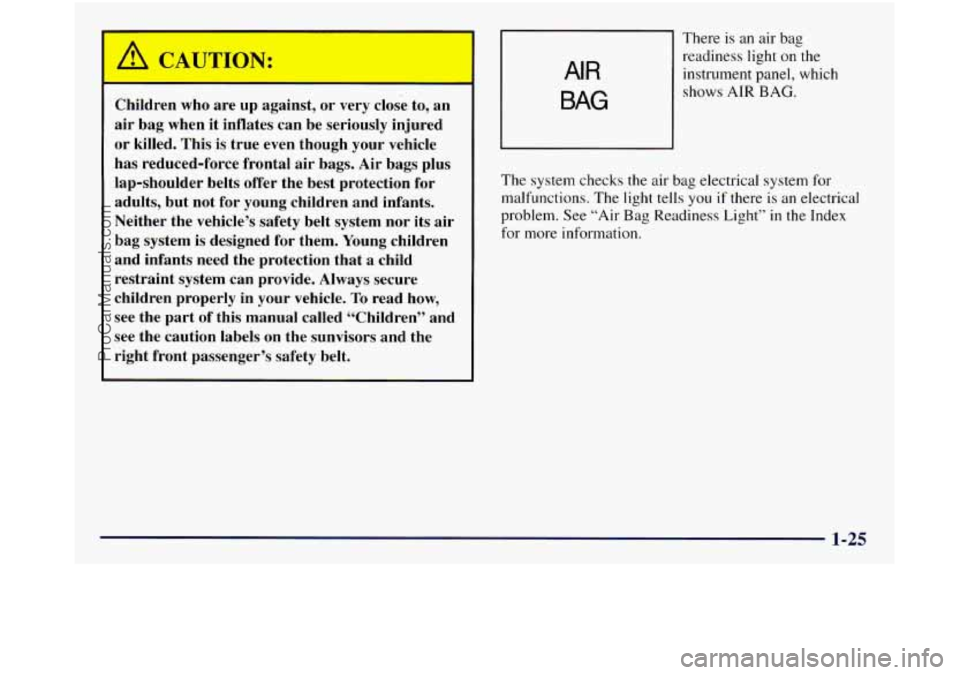
1
l Children who are up against, or very close to, an
air bag when it inflates can be seriously injured
or killed. This
is true even though your vehicle
has reduced-force frontal air bags. Air bags plus lap-shoulder belts offer the best protection for
1 adults, but not for young children and infants.
Neither the vehicle’s safety belt system nor its air
bag system is designed for them. Young children
and infants need the protection that
a child
restraint system can provide. Always secure
children properly in your vehicle.
To read how,
see the part of this manual called “Children” and
see the caution labels on the sunvisors and the
right front passenger’s safety belt.
~
AIR
BAG
There is an air bag
readiness light
on the
instrument panel,
which
shows AIR BAG.
The system checks the air bag electrical system for
malfunctions. The light tells you if there is an electrical
problem. See “Air Bag Readiness Light”
in the Index
for more information.
1-25
ProCarManuals.com
Page 38 of 452
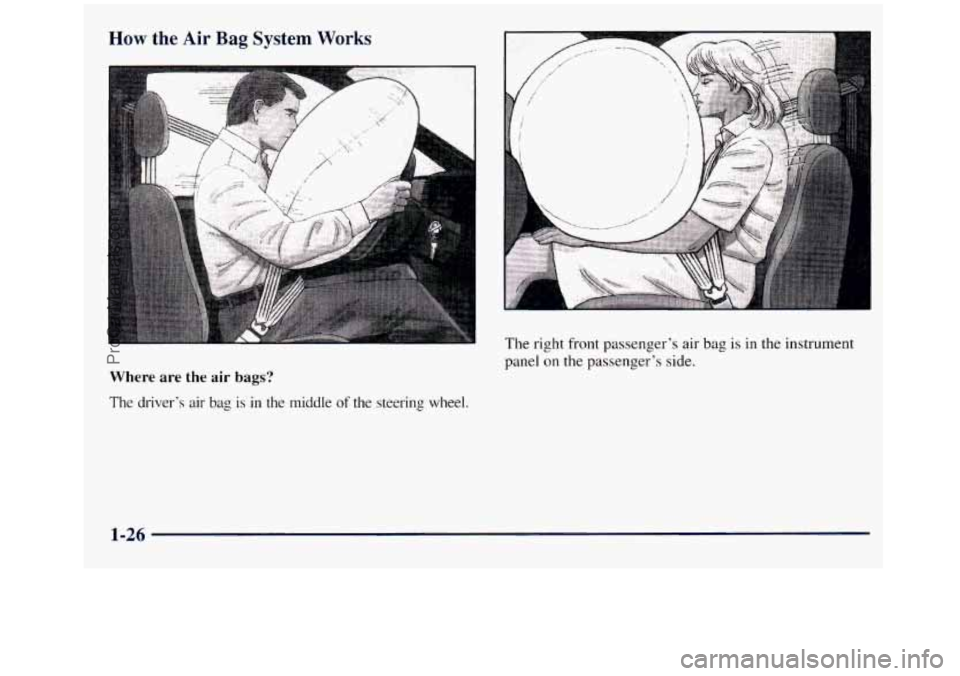
How the Air Bag System Works
Where are the air bags?
The driver’s air bag is in the middle of the steering wheel. The right front passenger’s air
bag
is in the instrument
panel
on the passenger’s side.
1-26
ProCarManuals.com
Page 39 of 452
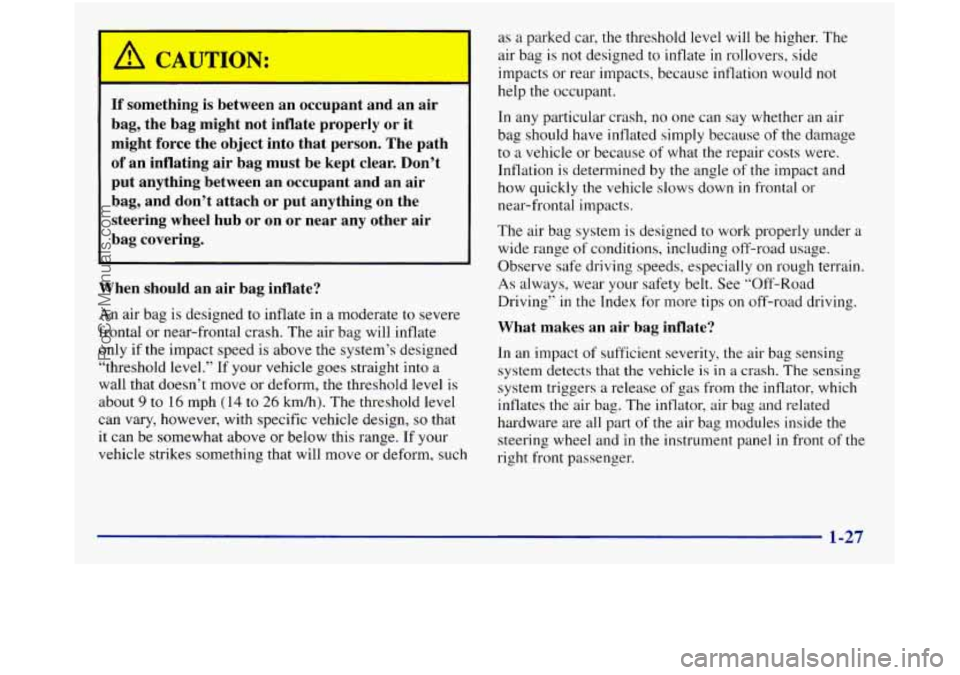
p, CAUTION:
If something is between an occupant and an air
bag, the bag might not inflate properly or it
might force the object into that person. The path
of an inflating air bag must be kept clear. Don’t
put anything between an occupant and an air
bag, and don’t attach or put anything on the
steering wheel hub or on or near any other air
bag covering.
When should an air bag inflate?
An air bag is designed to inflate in a moderate to severe
frontal or near-frontal crash. The air bag will inflate
only if the impact speed
is above the system’s designed
“threshold level.” If your vehicle goes straight into a
wall that doesn’t move or deform,
the threshold level is
about
9 to 16 mph (14 to 26 km/h). The threshold level
can vary, however, with specific vehicle design,
so that
it can be somewhat above or below this range. If your
vehicle strikes something that will move or deform, such as
a parked car, the threshold
level will be higher. The
air bag
is not designed to inflate in rollovers, side
impacts or rear impacts, because inflation would not
help the occupant.
In any particular crash,
no one can say whether an air
bag should have inflated simply because of the damage
to a vehicle or because of what the repair costs were.
Inflation is determined by the angle of the impact and
how quickly the vehicle slows down
in frontal or
near-frontal impacts.
The air bag system is designed to work properly under a
wide range
of conditions, including off-road usage.
Observe safe driving speeds, especially
on rough terrain.
As always, wear your safety belt. See ”Off-Road
Driving’‘
in the Index for more tips on off-road driving.
What makes an air bag inflate?
In an impact of sufficient severity, the air bag sensing
system detects
that the vehide is in a crash. The sensing
system triggers a release
of gas from the inflator, which
inflates
the air bag. The inflator, air bag and related
hardware are all part
of the air bag modules inside the
steering wheel and in the instrument panel
in front of the
right front passenger.
1-27
ProCarManuals.com
Page 40 of 452
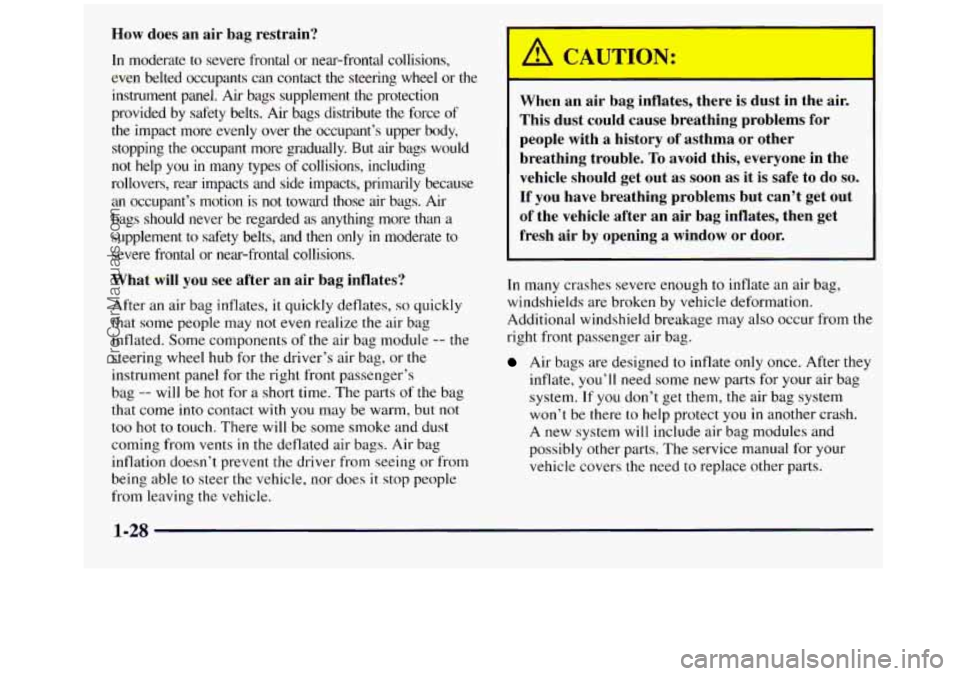
How does an air bag restrain?
In moderate to severe frontal or near-frontal collisions,
even belted occupants can contxt the steering wheel or the
instrument panel.
Air bags supplement the protection
provided by safety belts. Air bags distribute the force of
the impact more evenly over the occupant’s upper body,
stopping the occupant more gradually. But air bags would
not help you in many types of collisions, including
rollovers, rear impacts and side impacts, primarily because
an occupant’s motion is not toward those air bags. Air
bags should
never be regarded as anything more than a
supplement to safety belts, and then only
in moderate to
severe frontal or near-frontal collisions.
What will you see after an air bag inflates?
After an air bag inflates, it quickly deflates, so quickly
that some people may not even realize the air bag
inflated. Some components of the air bag module
-- the
steering wheel hub for the driver’s air bag, or
the
instrument panel for the right front passenger’s
bag
-- will be hot for a short time. The parts of the bag
that come into contact with
you may be warm, but not
too hot to touch. There will be some smoke and dust
coming from vents
in the deflated air bags. Air bag
inflation doesn’t prevent the driver from seeing or from
being able to steer
the vehicle, nor does it stop people
from leaving the vehicle.
When an air bag inflates, there is dust in the air.
This dust could cause breathing problems for
people with a history of asthma or other
breathing trouble,
To avoid this, everyone in the
vehicle should get out as soon as it
is safe to do so.
If you have breathing problems but can’t get out
of the vehicle after an air bag inflates, then get
fresh air by opening
a window or door.
In many crashes severe enough to inflate an air bag,
windshields are broken by vehicle deformation.
Additional windshield breakage may also occur from the
right front passenger air bag.
Air bags are designed to inflate only once. After they
inflate,
you’ll need some new parts for your air bag
system.
If you don’t get them, the air bag system
won’t be there to help protect you
in another crash.
A new system will include air bag modules and
possibly other parts. The service manual for your
vehicle covers the need to replace other parts.
ProCarManuals.com
Page 41 of 452

0 Your vehicle is equipped with a crash sensing and
diagnostic module, whch records information about
the air
bag system. The module records information
about the readiness
of the system, when the sensors are
activated
and driver’s safety belt usage at deployment.
switch
on the instrument. panel that you can use to
turn
off the passenger’s air bag. But use this switch
only when you want to secure a rear-facing child
restraint at the right front passenger’s position. See
“Securing a Child Restraint
in the Right Front Seat
Position”
in the Index for more on this, including
important safety information.
0 Unless you have a Crew Cab, your vehicle has a
A CAUT-ON:
If the right front passenger’s air bag is turned
off, the person sitting there won’t have the extra
protection
of an air bag. In a crash, the air bag
wouldn’t be able to inflate and help protect the
person sitting there. Make sure the
air bag is
turned on unless
you are using a rear-facing child
restraint in the right front seat position.
0 Let only qualified technicians work on your air bag
system. Improper service can mean that your air bag
system won’t work properly. See your dealer
for service.
1-29
ProCarManuals.com
Page 42 of 452

I NOTICE:
If you damage the covering for the driver’s or the
right front passenger’s air bag, the bag may not
work properly. You may have to replace the air
bag module in the steering wheel or both the air
bag module and the instrument panel for the right front passenger’s air bag.
Do not open or
break the air bag coverings.
Servicing Your Air Bag-Equipped Vehicle
Air bags affect how your vehicle should be serviced.
There are parts
of the air bag system in several places
around your vehicle. You don’t want the system to
inflate while someone is working on your vehicle. Your
dealer and the service manual have information about
servicing your vehicle and the air
bag system. To
purchase a service manual, see “Service and Owner
Publications”
in the Index.
If your vehicle ever gets into a lot of water -- such as
water up to the carpeting or higher -- or if water enters
your vehicle
and soaks the carpet, the air bag controller
can be soaked and ruined. If this ever happens, and then
you start your vehicle, the damage could make the air
bags inflate, even if there’s no crash.
You would have to
replace the air bags
as well as the sensors and related
parts. If your vehicle is ever
in a flood? or if it‘s exposed
to water that soaks the carpet, you can avoid needless
repair costs
by turning off the vehicle immediately.
Don’t
let anyone start the vehicle, even to tow it, unless
the battery cables are first disconnected.
I
For up to 10 minutes after the ignition key is
turned off and the battery is disconnected, an air
bag can still inflate during improper service. You
can be injured if you are close to an air bag when
it inflates. Avoid
wires wrapped with yellow tape
or yellow connectors. They are probably part of
the
air bag system. Be sure to follow proper
service procedures, and make sure the person
performing work for you
is qualified to do so.
~~
The ail- bag system does not need regular maintenance.
1-30
ProCarManuals.com
Page 62 of 452
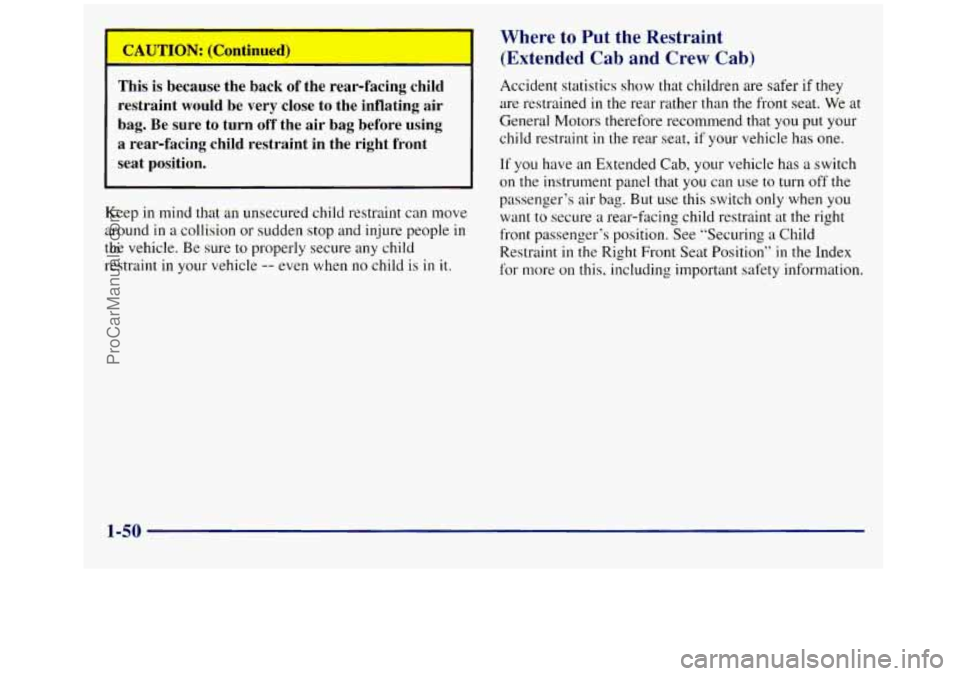
This is because the back of the rear-facing child
restraint would be very close to the inflating air
bag. Be
sure to turn off the air bag before using
a rear-facing child restraint in the right front
seat position.
Keep in mind that an unsecured child restraint can move
around
in a collision or sudden stop and injure people in
the vehicle. Be sure to properly secure any child
restraint in your vehicle
-- even when no child is in it.
Where to Put the Restraint
(Extended Cab and Crew Cab)
Accident statistics show that children are safer if they
are restrained
in the rear rather than the front seat. We at
General Motors therefore recommend that you put your
child restraint in the rear seat, if
your vehicle has one.
If you have an Extended Cab, your vehicle has a switch
on the instrument panel that you can
use to turn off the
passenger’s air bag. But use this switch only when you
want to secure
a rear-facing child restraint at the right
front passenger’s position. See ”Securing
a Child
Restraint
in the Right Front Seat Position” in the Index
for more on this, including important safety information
1-50
ProCarManuals.com